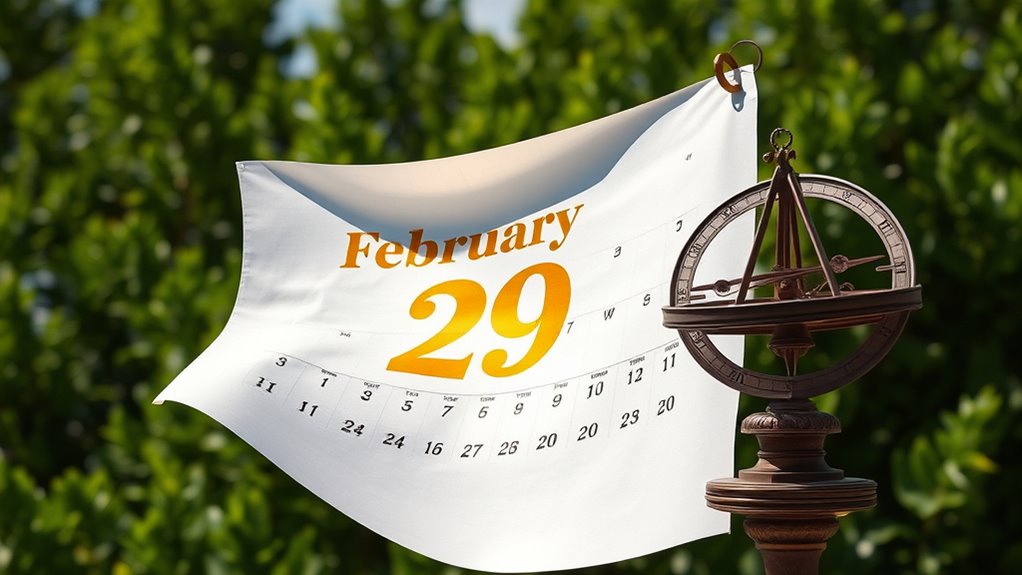Leap years exist to keep our calendar in sync with the Earth’s orbit, which is about 365.2422 days. Without leap years, our seasons would eventually shift, leading to confusion for agriculture and cultural events. Every four years, we add an extra day in February, with a few exceptions for century years. This clever system balances our calendar with natural cycles and guarantees we celebrate seasons at the right time. Discover more about this fascinating calculation!
Key Takeaways
- Leap years correct calendar alignment with Earth’s 365.2422-day orbital period to prevent seasonal drift.
- The Gregorian calendar adds an extra day every four years, with specific rules for century years.
- Without leap years, the calendar would misalign with seasons, impacting agriculture and cultural events.
- The leap year system demonstrates humanity’s effort to synchronize timekeeping with natural phenomena.
- Leap years reflect the intersection of scientific precision and cultural practices in measuring time.

Leap years can be a bit puzzling, but they’re indispensable for keeping our calendars in sync with the Earth’s orbit around the Sun. You might wonder why we can’t just stick to a simple 365-day year without any complications. The truth is, the Earth takes about 365.2422 days to complete one full orbit around the Sun. This discrepancy means that if we didn’t add an extra day every four years, our calendar would slowly drift out of alignment with the seasons. That’s where leap years come in as a necessary calendar correction.
To understand the leap year concept, consider how astronomical calculations impact our daily lives. The Gregorian calendar, which most of the world uses today, incorporates leap years to address this issue. By adding an extra day in February every four years, we’re able to maintain a closer alignment to the Earth’s actual orbital period. However, it’s not as straightforward as simply adding a day every four years; that would still leave us with a slight overcorrection. So, the calendar includes additional rules: years divisible by 100 aren’t leap years, unless they’re also divisible by 400. This means that while the year 2000 was a leap year, the year 1900 wasn’t.
Understanding leap years reveals how our calendar aligns with Earth’s orbit, ensuring seasonal consistency through precise adjustments.
You can see how these rules help fine-tune our calendar. If we didn’t have these adjustments, we’d find ourselves celebrating the summer solstice in the middle of winter in just a few centuries. The leap year system helps ensure that our seasons remain consistent with our calendar, a necessity for agriculture, holidays, and various cultural events. Interestingly, just as the leap year corrects our calendar, somatic therapy techniques serve to adjust our emotional and physical alignment by integrating mind and body for healing.
When you look at the bigger picture, leap years become a fascinating intersection of science and history. They’re not just about adding a day; they represent humanity’s attempt to understand and organize time according to the natural world. This balance between our calendar and the Earth’s movements is a proof to our ingenuity. So, the next time February 29th rolls around, you’ll appreciate that extra day as a crucial tool for maintaining harmony between our lives and the cosmos. Leap years, in all their complexity, ensure that our schedules align with the rhythm of the Earth, reminding us that time is both a scientific and a cultural construct.
Frequently Asked Questions
How Do Different Cultures Celebrate Leap Years?
Different cultures celebrate leap years with unique cultural traditions and festival celebrations. For instance, in Greece, couples avoid getting married in a leap year, believing it brings bad luck. Meanwhile, in Ireland, it’s a time for women to propose to men, flipping traditional roles. You might also find festivals in some regions that honor the extra day with music, dance, and community gatherings, showcasing the joy of an extended calendar.
What Happens to Birthdays on February 29?
If you’re born on February 29, it feels like you’ve got the rarest birthday on Earth! You’ll need to make some birth date adjustments since your actual birthday only rolls around every four years. Many leap year myths suggest you should celebrate on February 28 or March 1, but it’s really up to you. Embrace your unique day and throw a party whenever you feel like it—after all, you deserve it!
Are Leap Years the Same Everywhere in the World?
Leap years aren’t the same everywhere in the world due to calendar discrepancies and time zone effects. While most countries follow the Gregorian calendar, some use different systems, like the Julian calendar, which can lead to variations in leap year occurrences. You might find that some cultures have unique traditions around leap years, and local practices can influence how birthdays and anniversaries are celebrated in this unusual year. So, it’s not universally consistent!
Can a Year Be a Leap Year if It Ends in 00?
No, a year that ends in 00 isn’t automatically a leap year. Isn’t that ironic? You’d think a century would deserve an extra day! However, to maintain astronomical alignment, those years must be divisible by 400 to be leap years. So, while 1900 wasn’t a leap year, 2000 was. This calendar correction helps keep our calendar in sync with Earth’s orbit around the sun. So, double-check those century years!
How Often Do Leap Seconds Occur?
Leap seconds typically occur every few years, though there’s no set schedule. You’ll find they’re added to keep our clocks in line with precise timekeeping and astronomical observations. Since the Earth’s rotation isn’t perfectly steady, these adjustments help maintain synchronization. Sometimes, you might notice two leap seconds added in one year, while other years might pass without any. Keeping track of time accurately is essential for various scientific and navigational purposes.
Conclusion
In a world where precision guides our modern lives, leap years remind us of nature’s intricate rhythms. While our calendars may endeavor for order, they can’t ignore the subtle dance of the Earth around the Sun. This contrast between human structure and cosmic chaos highlights our desire to connect with the universe, grounding us in its vastness. So, as you mark February 29 on your calendar, remember it’s not just an extra day—it’s a celebration of balance.










